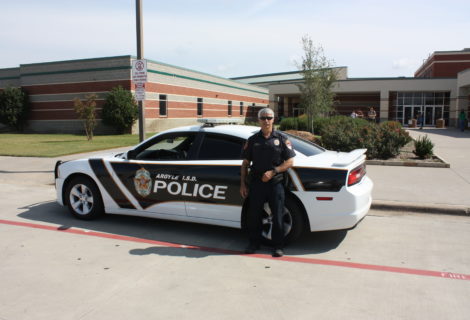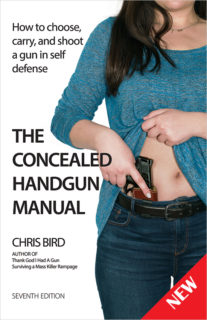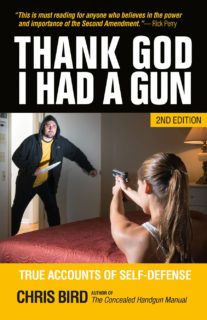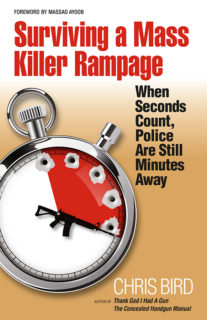Campus Carry begins at Texas Two-Year Colleges
 As of August 1, two-year colleges in Texas allow adult students, staff and faculty on their premises to carry concealed handguns if they have concealed handgun or right-to-carry licenses. Although there are exclusionary zones such as science labs and sports areas, it is a good second step. The first step happened on August 1 a year ago when four-year universities allowed concealed carry. Now, two-year colleges stand less chance of hosting a Virginia Tech scenario with its 47 casualties in eleven minutes.
As of August 1, two-year colleges in Texas allow adult students, staff and faculty on their premises to carry concealed handguns if they have concealed handgun or right-to-carry licenses. Although there are exclusionary zones such as science labs and sports areas, it is a good second step. The first step happened on August 1 a year ago when four-year universities allowed concealed carry. Now, two-year colleges stand less chance of hosting a Virginia Tech scenario with its 47 casualties in eleven minutes.
In a recent statement, Students for Concealed Carry celebrated the one-year anniversary of concealed carry at Texas four-year universities without any problems.
“Not a single university has reported a resulting assault, suicide attempt, fatality, or injury. We hope this track record will inspire university regents, state legislators, and the Office of the Attorney General to work to strike down the handful of university policies that continue to circumvent the clear intent of Senate Bill 11 by prohibiting many—and in some cases all—license to carry (LTC) holders from carrying concealed handguns on campus.”
On July 6, 2017, U.S. District Judge Lee Yeakel threw out a law suite by three UT Austin professors seeking to halt the law. They wanted to ban guns from their classrooms. Yeakel wrote: “Plaintiffs present no concrete evidence to substantiate their fears, but instead rest on mere conjecture.”
 UT Austin rules permit faculty members to post their offices as “gun free,” but not their classrooms.
UT Austin rules permit faculty members to post their offices as “gun free,” but not their classrooms.
A faculty member at Lone Star College – Montgomery said 23 faculty members have posted their offices to keep guns out.
Senate Bill 11, passed by the Texas Legislature in 2015, was a response to the shooting rampage by a 23-year-old Korean-born student at Virginia Polytechnic Institute, better known as Virginia Tech in April 2007. Honey in a blue northerner moves faster than the Texas Legislature and then it only does part of the job. Mass killers may be terrorists or nutcases but they are not stupid. They almost always pick “gun-free zones” to commit their murders.
As anyone with a thimble full of common sense knows, gun-free zones are a myth. They are not gun free. They are only free of law-abiding citizens with the best weapons to resist an attack. Mass killers do not obey gun laws or any other laws.
According to the Virginia Tech Incident Review Panel’s report, about 7 a.m. on April 16, 2007, the killer entered one of the dormitory buildings and shot and killed a male and a female student. The killer had a history of mental and behavioral problems including stalking female students. He escaped from the building without being seen.
Initially, police thought the shooting was a domestic dispute and searched for the woman’s boyfriend. Officers from the Virginia Tech and Blacksburg police departments searched for him. Both departments put their emergency response teams (ERTs) on alert in case they had to conduct a high-risk arrest. Officers from the two ERTs had trained together and knew each other.
About 9:30, the killer entered Norris Hall, a three-story older building containing faculty offices and classrooms. The gunman went up to the second floor and poked his head into several rooms where classes were in progress. He was armed with two semi-automatic handguns – a 9mm Glock and a .22 caliber Walther. He chained and padlocked the three main entrance doors to the building from the inside. This prevented anyone from entering or leaving. It also delayed the police response.
The Incident Review Panel’s report estimated that the killer started shooting about 9:40. He walked into Classroom 206, where Professor G.V. Loganathan was teaching Advanced Hydrology Engineering. Without warning the gunman shot and killed the professor then turned his guns on the students. He killed nine and wounded two. Only two students in that class were unscathed. The killer made several visits to four classrooms, shooting some students six times or more.
Students and faculty in nearby classrooms heard the shots but did not immediately realize what they were hearing. Some thought the sounds were from a nail gun being used in nearby construction, others thought they were noises from experiments in the chemistry lab on the first floor.
John Benner of Tactical Defense Institute says that in most of these mass murders, when someone starts shooting, people often don’t recognize the sound as gunfire and depending on the building layout, sometimes they don’t hear the shooting at all.
“What we are seeing is that it takes a long time for somebody to recognize what is going on and to call 9-1-1,” Benner says.
In his definitive book about the law enforcement response to Virginia Tech called Shooter Down, author John Giduck recounts the actions of the only student who tried to fight back. Matthew LaPorte, a 23-year-old Air Force Cadet was sitting in his uniform at the back of Room 211 when the killer forced his way in and started shooting. Cadet LaPorte ran along the window side of the room leaping over desks and students until he reached the front of the room. He turned towards the active killer and charged him. He soaked up eight rounds before he collapsed and died feet a few feet from his murderer.
As Giduck puts it, “Cadet LaPorte did what he had been trained to do, what his character and personal desire to serve the nation in uniform compelled him to do: fight to protect those who could not fight for themselves.”
Strangely there is no mention of this incident in the Virginia Tech Incident Review Panel’s report.
According to the report, police officers started to arrive at Norris Hall three minutes after the university police department received the first call. The officers were slowed by the chained entrances but eventually found a locked door to a maintenance shop. They shot the lock with a shotgun and entered the building. Two police teams entered and ran up the stairs to the second floor where the shots were coming from. They heard the last shot as the killer pumped a round into his head, ending the worst massacre by a gunman on a U.S. university campus. Although the police did not shoot or overcome the killer, their arrival is probably what prompted him to end his killing spree.
The review panel’s report estimates that between 9:40 and 9:51 – eleven minutes – the active killer shot and killed twenty-five students and five faculty members in the hallway and in four of the classrooms. He wounded seventeen other students. Another six students were injured when they jumped from the windows. In those eleven or so minutes, the killer fired at least 174 rounds from his two semi-automatic pistols.
In addition to Matthew LaPorte, another hero of the Virginia Tech shooting was undoubtedly seventy-six-year-old Professor Liviu Librescu, but he was from a different generation. He sacrificed himself by holding the door while ordering his students to escape through the windows. He understood the responsibilities of leadership—the leader, like the captain of a ship, saves himself last.
We talk of flight or fight as a response to danger. Flight is a respectable and preferable course of action. Students who jumped from the windows in Room 204 followed Librescu’s order and saved their lives. Those who tried, some successfully, some unsuccessfully, to block the doors have nothing to be ashamed of. They saw that action was needed and took it.
But if you are trapped, what about the other option: fight? Time magazine quoted one student in Room 211, who cowered under a desk while other students were being executed around him. He was waiting for it to be his turn. He heard the gunman reload three times, but no one apparently thought to attack him while his gun was out of action.
Another student in the same class who feigned death told Newsweek: “Nobody tried to get up and be a hero.”
The review panel’s report states: “Several students, some of whom were injured and others not, successfully played dead amid the carnage around them, and survived. …This worked for at least some students.”
The report made no mention of Matthew LaPorte or anyone trying to rush the shooter. Apparently this was fine with the panel. Its recommendations concerned action by police, to make sure that exterior doors cannot be chained shut, and that bomb threats be taken seriously. The focus of the report seems to be to absolve the police and administration of any responsibility, while failing to address how students could save their own lives. There was no recommendation that students should be taught to fight back.
“Virginia Tech was also a game changer. Law enforcement was in the absolute best position that they could possibly be in,” said John Benner of Tactical Defense Institute. “On campus at the time of the second shooting, they had two in-service tactical teams that were geared up and ready to go and they still lost (almost) fifty people, either killed or wounded.”
He said it only took the SWAT teams about eight minutes to get into Norris Hall from the time the Virginia Tech Police Department received the call. In almost all cases the unknown factor is the time it takes from when the shooting starts to when the first 9-1-1 call reaches the police.
“The time that we don’t know is: how long did it take to call 9-1-1 and how long did it take for them to process the call? Those are things that in most instances we don’t know, when it starts to the time somebody calls 9-1-1,” Benner said.
The review panel’s report estimated the time from when the shooting started to when the first 9-1-1 call reached the Virginia Tech police was about three minutes. Add the eight minutes it took the SWAT teams to reach Norris Hall and the shooting lasted about eleven minutes. With forty-seven faculty members and students killed or wounded, the active killer was hitting between four and five victims a minute, some of them as many as eight times.
“Time is a real problem,” John Benner said. “The only answer is armed people inside.”
Immediately after the Virginia Tech shooting, the local and national media were all over the incident like blowflies on a dead cow in August. They concentrated on the victims, on the university, on the police response, on the active killer’s obvious mental problems, and that the country obviously needed more gun-control laws. There were the pro forma comparisons to Columbine. The media were aided and abetted in calling for more gun-control laws by the usual suspects—the Brady Campaign to Prevent Handgun Violence, the Violence Policy Center, and other anti-self-defense groups.
While the media and anti-second-amendment organizations’ responses were predictable, in calling for more gun control. The response to Virginia Tech from the pro-gun, pro-self-defense citizens and organizations was also predictable. The feedback I heard again and again from people interested in taking responsibility for their own safety was: “If only one student there had had a gun . . . .”
But Virginia Tech was a “gun-free zone.” Even students and faculty members with concealed-handgun licenses were forbidden to take their guns on campus. In 2005 a student with a concealed handgun permit was disciplined for bringing a gun on campus.
For more than two years, the Virginia Citizens Defense League had been trying to get a law passed in the legislature that would prevent public colleges and universities from banning guns from their campuses. The bills were stalled in committee after much lobbying by Virginia Tech and other institutes of supposed higher learning in the state.
Apparently Virginia Tech spokesman Larry Hincker was pleased the bill in 2006 was defeated. He was quoted in The Roanoke Times as saying: “I’m sure the university community is appreciative of the General Assembly’s actions because this will help parents, students, faculty, and visitors feel safe on our campus.”
Right.
In the days and weeks after the Virginia Tech shooting some people spoke in favor of allowing students and faculty members who have concealed-handgun licenses to carry handguns on campus just as they can off campus.
The shooting at Virginia Tech made some students realize how vulnerable they were and it spawned an organization called Students for Concealed Carry (SCC).
It does seem ridiculous that young soldiers who have served their country in Iraq or Afghanistan should come home and be denied the right to carry concealed handguns for protection while students at a college or university.
Various people weighed in, in support for students and faculty members being able to protect themselves on campus. Texas Governor Rick Perry was quoted as saying that Texans with concealed-handgun licenses should be able to carry anywhere. He included college campuses, bars, courthouses, and churches.
Alan Gottlieb, chairman of the Citizens Committee for the Right to Keep and Bear Arms, agreed. He said every tragic school shooting and some other mass shootings had one thing in common. “They all happened in so-called ‘gun-free zones,’” he said. “You can pass all the laws you want, but the only proven way to stop shootings in ‘gun-free zones’ is an armed response.”
While after Virginia Tech many people railed against the ostrich-like attitude of most educators towards guns on campuses, another more disturbing question was being raised: Why did none of the students in Norris Hall fight back? At the time the attempt of Air Force Cadet Matthew LaPorte to rush the gunman was not known to the media.
The answers varied, but the theme seemed to be that we have produced an emasculated generation of young adults who have been socialized by educators to obey orders and avoid conflict at all costs.
Nationally syndicated radio-talk-show host Neal Boortz opined: “It seems that standing in terror waiting for your turn to be executed was the right thing to do, and any questions as to why twenty-five students didn’t try to rush and overpower (the gunman) are just examples of right-wing maniacal bias. Surrender—comply—adjust.”
Syndicated columnist Michelle Malkin stated: “Instead of teaching students to defend their beliefs, American educators shield them from vigorous intellectual debate. Instead of encouraging autonomy, our higher institutions of learning stoke passivity and conflict-avoidance. And as the erosion of intellectual self-defense goes, so goes the erosion of physical self-defense.”
National Review columnist Mark Steyn refers to a “culture of corrosive passivity.”
“It’s deeply damaging to portray fit, fully-formed adults as children who need to be protected. We should be raising them to understand that there will be moments in life when you need to protect yourself—and, in a ‘horrible’ world, there may come moments when you have to choose between protecting yourself or others,” Steyn wrote.
Philip Van Cleave, president of Virginia Citizens Defense League, says Virginia Tech still maintains its no-gun policy. However, Liberty University, the largest private Christian university in the country, has embraced campus carry. Liberty with more than 110,000 students is about four times the size of Virginia Tech.
Chris Bird is author of The Concealed Handgun Manual and Thank God I Had a Gun. His latest book is Surviving a Mass Killer Rampage: When Seconds Count, Police Are Still Minutes Away.




